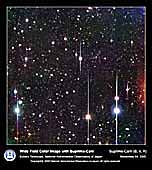Press Release
Wide Field Color Image with Suprime-Cam
November 14, 2000
 Low Res. (216 KB) High Res. (2.48 MB) Caption |
Object Name: Wide Field Color Image with Suprime-Cam Telescope: Subaru Telescope / Prime Focus Instrument: Suprime-Cam Filter: B (0.45 micron) , V (0.55 micron) , R (0.65 micron) Color: Blue (B), Green (V) , Red (R) Date: UT2000 August 3 (B), June 8 (V), August 2 (R) Exposure: 40 min (B) , 25 min (V), 30 min (R) Field of View: 24 arcmins Orientation: North up, east left Position: Hercules |
Explanation:
Suprime-Cam
(Subaru Prime Focus Camera) is a wide field camera
for visible light, installed at the prime focus of Subaru
Telescope. It can currently produce a 24 x 24 arcminute
square image with each exposure, an area almost equal
to the size of the full moon (about 31 arcminutes in diameter,
see supplement). At present,
Subaru is the only large telescope in the world (primary
mirror larger than 4 meters in diameter) that can take
such a large-scale image. The combination of large field
coverage and large light-gathering power makes the Subaru
Telescope / Suprime-Cam combination the most powerful
tool available for studying faint celestial objects spread
out over extended regions of the sky.
The builders of Suprime-Cam have been researching the
large-scale structure in the universe through the "weak
lensing" method while adjusting the instrument. The
weak lensing method estimates the mass of nearer galaxies
by measuring distortion in shapes of the more distant
galaxies caused by gravitational
lensing (the phenomenon where light from a farther
object is bent by the gravity of a nearer object). The
aim of the research is to determine the mass distribution
over a wide area in the universe.
The image shown here is a good example of what Suprime-Cam
can achieve in terms of detail and faintest objects visible.
Even though the field-of-view is large, there is no compromise
in the finest details that can be imaged by Suprime-Cam.
The limit is set by the Earth's atmosphere, which, from
Mauna Kea, is exceptionally steady. Suprime-Cam has already
demonstrated its
ability to resolve details as small as 0.3 arcseconds
in diameter, about one six-thousandths the size of
the full moon. The image shown here has a resolution of
about 0.6 arcseconds. The peak efficiency of Suprime-Cam
is also very good, with better than 70% of the light entering
the telescope being detected. The faintest details visible
in the color image are about 100 million times fainter
than what can be seen with the unaided eye.
The image contains more than 30,000 objects within approximately
10 billion light years of the Earth. The brightest features
in the image are faint stars belonging to our own Milky
Way Galaxy. The streaks running vertically from these
stars are artifacts created when the electronic detectors
(CCDs) are over exposed. Many stars are visible in this
image; but most of the objects seen are actually other
galaxies many tens of thousands of times further than
the furthest stars in our galaxy. This image with its
tremendous number of galaxies shown in good detail is
exactly what's required for doing the weak lensing analysis.
In the course of their research, the Suprime-Cam group
discovered a previously unknown cluster of galaxies (*)
within this image (see supplement).
The distance between the Earth and the cluster is estimated
to be approximately 5 billion light years. It is expected
that many such serendipitous discoveries will occur as
a matter of course for researchers using Suprime-Cam on
Subaru Telescope.
Open use
of Subaru Telescope will start in December of this
year. For the first semester, "S00", running
from December 2000 to March 2001, two of Subaru's seven
first-phase observational instruments were deemed ready
for general use: Suprime-Cam; and the
Infrared Camera and Spectrograph (IRCS). The 36 available
nights will be used for 26 research projects. The remainder
of time will be assigned for engineering work on the telescope
and its instruments.
(*) A cluster of galaxies is defined as a group of more
than 50 galaxies within a region approximately 10 million
light years across.
Supplementary Image: Low
Res. (187 KB) / High Res.
(1.44 MB)